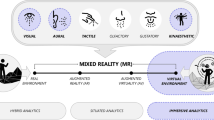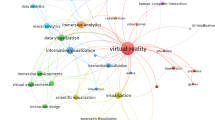Abstract
The continuous growth in technology has brought some revolutionary changes in various domains, resulting in considerable data accumulation. Although traditional segregation and displaying data might still be possible, it may be difficult for users to extract the quintessence from them. Data is one of the most practical terms, irrespective of its origin or time, and it does have an interesting story to convey. There is a need for the data to be presented more innovatively, so that obscure and complex data can be comprehended easily. Still, it all may come down to good storytelling in many cases and enabling people to connect with the data. With this research study, we leverage virtual reality concepts to compare two techniques to visualise data - traditionally numerical and creative. The aim is to bring data into virtual reality to help one interact and visualise data in a three-dimensional environment, thereby adding more fun and compelling ways to analyse and evaluate. With this research, we would like to devise various design paradigms that could be used to display or represent data in a virtual environment. Having two different virtual environments representing the office and nature, users (N = 19) of the user study had to evaluate if they could recognise the connection between numerical and creative visualisation. Interestingly, users have reported a higher arousal intensity (measure by SAM questionnaire) when the environment and the expected visualisation are not matching. Further on, results suggest that the different kind of visualisation can be more effective and can be used for future VR applications.
Access this chapter
Tax calculation will be finalised at checkout
Purchases are for personal use only
Similar content being viewed by others
References
Bowman, D.A., Kruijff, E., LaViola, J.J., Jr. Poupyrev, I.: 3D user interfaces: theory and practice (2005)
Bradley, M.M., Lang, P.J.: Measuring emotion: the self-assessment manikin and the semantic differential. J. Behav. Ther. Exp. Psychiatry 25(1), 49–59 (1994). https://doi.org/10.1016/0005-7916(94)90063-9. https://www.sciencedirect.com/science/article/pii/0005791694900639
Brooke, J.: SUS: A ‘quick and dirty’ usability scale. In: Jordan, P.W., Thomas, B., McClelland, I.L., Weerdmeester, B. (eds.) Usability Evaluation in Industry, 1st edn., pp. 189–194. CRC Press (1996)
Moere, A.V.: Aesthetic data visualization as a resource for educating creative design. In: Dong, A., Moere, A.V., Gero, J.S. (eds.) Computer-Aided Architectural Design Futures (CAADFutures) 2007, pp. 71–84. Springer, Dordrecht (2007). https://doi.org/10.1007/978-1-4020-6528-6_6
Moran, A., Gadepally, V., Hubbell, M., Kepner, J.: Improving big data visual analytics with interactive virtual reality. In: 2015 IEEE High Performance Extreme Computing Conference (HPEC), pp. 1–6. IEEE (2015)
Millais, P., Jones, S.L., Kelly, R.: Exploring data in virtual reality: comparisons with 2D data visualizations (2018). https://purehost.bath.ac.uk/ws/portalfiles/portal/168354128/paper1278.pdf
Loftin, R.B., Chen, J.X.: Visualization using virtual reality. In: Johnson/Hansen: The Visualization Handbook, pp. 465–476 (2004). http://www.uvm.edu/pdodds/files/papers/others/2004/loftin2004a.pdf
Steinicke, F., Bruder, G., Hinrichs, K., Ropinski, T., Lopes, M.: 3D user interfaces for collaborative work. In: Human Computer Interaction. IntechOpen (2008)
Stellmach, S., Dachselt, R.: Looking at 3D user interfaces. In: CHI 2012 Workshop on the 3rd Dimension of CHI (3DCHI): Touching and Designing 3D User Interfaces, pp. 95–98 (2012)
Unity Technologies: Unity. https://unity.com/
Valtchanov, D., Barton, K.R., Ellard, C.: Restorative effects of virtual nature settings. Cyberpsychol. Behav. Soc. Netw. 13(5), 503–512 (2010)
Author information
Authors and Affiliations
Corresponding author
Editor information
Editors and Affiliations
Rights and permissions
Copyright information
© 2021 Springer Nature Switzerland AG
About this paper
Cite this paper
Kojić, T., Vergari, M., Thangaraj, R., Braune, M., Voigt-Antons, JN. (2021). Influence of Visualisation Design of Data Streams on User Experience in Virtual Reality. In: Stephanidis, C., Antona, M., Ntoa, S. (eds) HCI International 2021 - Posters. HCII 2021. Communications in Computer and Information Science, vol 1420. Springer, Cham. https://doi.org/10.1007/978-3-030-78642-7_36
Download citation
DOI: https://doi.org/10.1007/978-3-030-78642-7_36
Published:
Publisher Name: Springer, Cham
Print ISBN: 978-3-030-78641-0
Online ISBN: 978-3-030-78642-7
eBook Packages: Computer ScienceComputer Science (R0)




